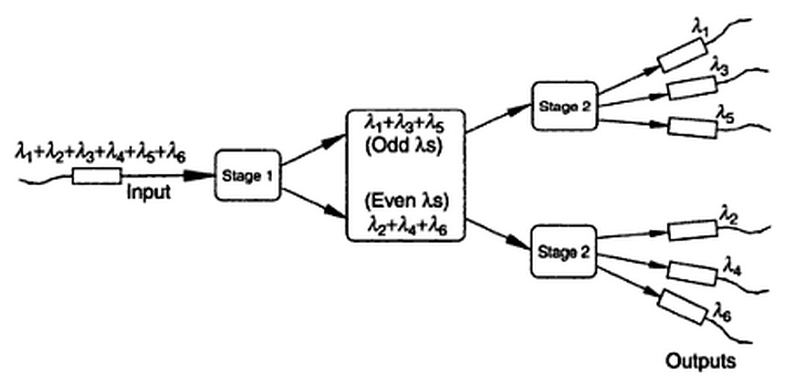Sending email is a commonplace occurrence in our daily life. When you send an email to a friend in another city, it will firstly join up with other messages being transmitted in your city, and then get dropped off at the correct destination in the correct city. How do all of these messages get to join together and be transmitted without getting mixed up? This process is achieved through the use of multiplmexing technology, which is a method that combines multiple analog message signals or digital data streams into one signal over a shared medium. Actually, multiplexing is widely used in many telecommunications applications. This article will introduce multiplexing technology from the aspect of common technologies used in multiplexing.
Optical multiplexing filter is an essential component in multiplexing technology, which is a physical device that combines each wavelength with other wavelengths (as shown in the following figure). Many technologies are applied in multiplexing, including thin-film filter (TFF), fiber bragg grating (FBG), arrayed waveguide grating (AWG) and interleaver, periodic filter, and frequency slicer.

TFF
Optical TFF typically consists of multiple alternating layers of high- and low-refractive-index material deposited on a glass or polymer substrate. This substrate is made to let only photons of a specific wavelength pass through, while all others are reflected.
FBG
A bragg grating is made of a small section of fiber that has been modified by exposure to ultraviolet radiation to create periodic variations in the refractive index of the fiber. And the process of creating periodic variations will generate wavelength-specific dielectric mirrors. Thus, the FBG can reflect particular wavelengths of light and transmit all others.
AWG
AWG devices can multiplex a large number of wavelengths into a single optical fiber. These devices are designed on the fundamental principle of optics that light waves of different wavelengths interfere linearly with each other. That’ to say, if each channel in an optical communication network makes use of light of a slightly different wavelength, then the light from a large number of these channels can be carried by a single optical fiber.
Interleaver, Periodic filter, and Frequency Slicer
Interleaver, periodic filter and frequency slicer are often used together to perform the function of multiplexing. The following figure shows how interleaver, periodic filter and frequency slicer work together to make a multiplexer device. Periodic filter is in stage 1, which is an AWG. Stage 2 represents the frequency slicer which is another AWG. The interleaver is at the output part, which is provided by six bragg gratings. Six wavelengths (λ) are received at stage 1 which breaks the wavelengths down into odd and even wavelengths. Then the odd and even wavelengths go to stage 2 respectively. Finally, they are delivered by the interleaver in the form of six discrete, interference-free optical channels.

All in all, the usual goal of multiplexing is to enable signals to be transmitted more efficiently over a given communication channel rather than save bandwidth. Nowadays, the most popular multiplexing technology is wavelength division multiplex (WDM), which can be divided into coarse wavelength division multiplexing (CWDM) and dense wavelength division multiplexing (DWDM). It is hoped that multiplexing technology would offer significant gains in bandwidth efficiency.
Originally published at www.fiber-optical-networking.com/
No comments:
Post a Comment